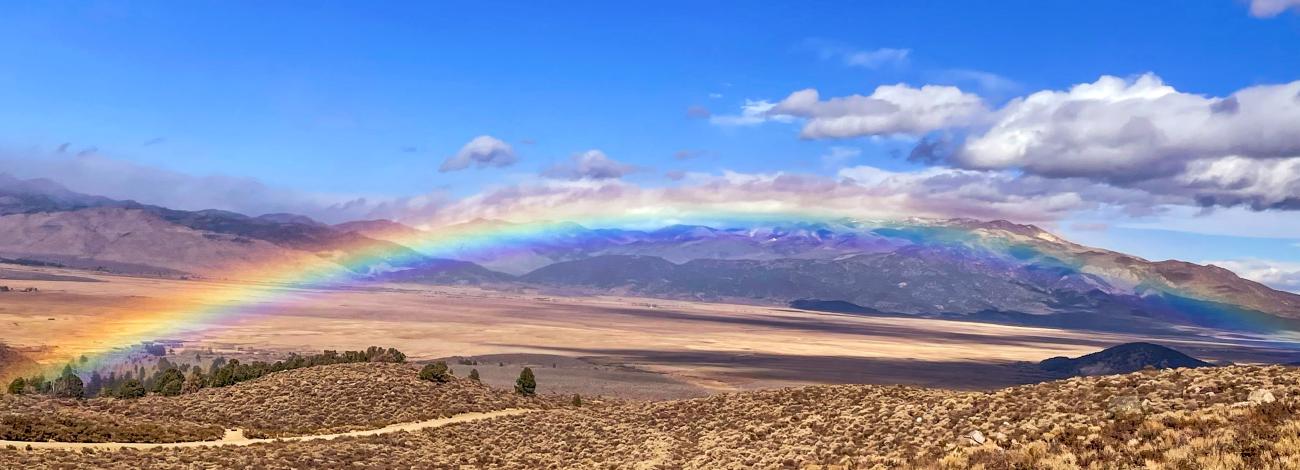
The BLM: A Sound Investment for America 2022
Valuing America's Public Lands: Socioeconomic Impact for 2023 is available now.
As steward for much of America’s public lands, the Bureau of Land Management (BLM) manages some of the nation’s most historic and scenic landscapes, as well as vast natural resources, for the benefit of all Americans. These public lands include rangelands, forests, mountains, arctic tundra, and deserts and encompass 10 percent of the nation’s surface and approximately one-third of its subsurface mineral resources.
The BLM’s balanced management of these lands advances responsible energy policy, promotes restoration, provides recreation for all, and fosters conservation. Billions of dollars and hundreds of thousands of jobs are supported from activities related to the BLM’s land management.
The interactive charts and other information below provide a snapshot of how authorized use and management of BLM-administered lands supported $201 billion in economic output and nearly 783,000 jobs across the country in fiscal year (FY) 2021. Much of the data on this web page is based on the BLM's Sound Investment 2022 publication (PDF).
These uses also generated substantial revenue for the U.S. Treasury and state governments. In FY 2021, $2 billion was redistributed to state and local governments for improvement projects and public services under various revenue-sharing programs, including the Taylor Grazing Act, the Mineral Leasing Act for Acquired Lands, Payments in Lieu of Taxes, and the Secure Rural Schools and Community Self-Determination Act.
The figures and tables below report the economic contributions stemming from specific resource uses supported by BLM-managed lands and by BLM’s labor and non-labor expenditures.
Metrics for these contributions include:
- Jobs: an annual average of the number of full-time, part-time, and seasonal employees. Jobs do not equal full-time equivalents.
- Output: the market value of production of a good or service. Output can also be expressed in terms of total sales value, or in terms of the cost to produce a good or service.
Each resource use supports direct and total contributions. The figures report TOTAL JOBS and TOTAL OUTPUT, while the files at the bottom of the page report both direct and total contributions.
- Direct contributions: reflect the economic activity directly attributable to the resource use in question, such as the money spent by visitors, or mining jobs supported by the production of federal minerals.
- Total contributions: include direct economic activity plus its ‘ripple effect’ throughout the economy. These ripples include economic activity in sectors that support activity in directly affected sectors, and economic activity generated by employees spending their labor income.
Using the interactive charts
The charts are dynamic and interactive. Hover your mouse or tap with your finger to see the value of a bar or a pie wedge. You can toggle sectors on the pie chart by clicking them. This is helpful to enhance the view of smaller values that appear with larger values of data. Full tables of the data in the dynamic charts are provided below.
$201 Billion in Total Economic Output
* National totals may differ from the sum of individual state numbers because they take into account activity across state borders and average industry productivity across states.
** Under certain laws, the BLM makes payments to states and counties that are used to help fund schools, road improvements, infrastructure, and public services within their jurisdictions.
Total Economic Output By State Office
Total Jobs Supported by State and Sector
* National totals may differ from the sum of individual state numbers because they take into account activity across state borders and average industry productivity across states.
** Under certain laws, the BLM makes payments to states and counties that are used to help fund schools, road improvements, infrastructure, and public services within their jurisdictions.
Total Jobs By State Office
Benefits of Public Lands
In addition to supporting economic vitality, BLM programs and managed lands benefit families and communities across the United States in ways that are not always reflected in economic activity. Benefits aren’t measured by what people have to spend, but rather what they would be willing to spend. Many of the benefits of public lands are nonmarket benefits stemming from the value individuals attribute to experiences, natural resources, or the existence of particular ecological conditions that don’t involve transactions and therefore lack prices. Examples of some important benefits sustained by BLM-managed lands include:
- Maintaining ecosystem functions that support critical ecosystem services, such as habitat for pollinators and clean water
- Providing opportunities for subsistence hunting and fishing, and collection of forest products for personal use
- Supporting education, scientific research, and volunteer opportunities
- Promoting fire resiliency and recovery
- Discovering, studying and preserving archaeological sites and paleontological resources
- Remediation of Abandoned Mine Lands and other legacy effects of past mining activity
- Providing recreational opportunities, which are valued beyond cost in terms of the experience enjoyed by the participant
- Restoring and conserving habitat for sensitive, threatened, and endangered species.
- Sustaining healthy wild horse and burro populations, which are valued as an important part of the culture and landscape of the West.
Data Tables
- Total Economic Output
-
- Total Jobs
-
- Direct Economic Output
-
- Direct Jobs
-
